 |
 |
|
|

|
Current State of the Art
Thin film solid state batteries are constructed by depositing the components of the battery as thin films (less than 5μm) on a substrate. The typical structure of a thin film solid state battery is illustrated in the schematic cross section shown in Figure 1.
 Figure 1. Schematic cross section of a thin film solid-state battery The cathode and anode current collectors (approximately 0.3μm thick) are deposited by sputtering of the appropriate metal in argon (Ar) atmosphere. Cathode films of LiCoO2or LiMn2O4 are deposited by RF magnetron sputtering of sintered targets of the respective compounds in Ar + O2 while films of V2O5 are deposited by reactive sputtering of V in Ar + O2. A sputtered LiPON electrolyte film covers the cathode and a portion of the substrate up to the anode current collector in order to insulate the substrate from direct contact with the anode.For a thin film lithium battery, a thin layer of lithium metal is thermally evaporated on LiPON as the anode. For a thin film lithium ion battery, a thin layer of Sn3N4 (deposited by sputtering of Sn target in N2 environment) is used as the anode. Finally, the battery is sealed. Intrinsically Safe Because thin film batteries are manufactured using all solid state materials and an inorganic glass electrolyte, these batteries are intrinsically safe. None of the risks such as spilling, boiling or gassing associated with traditional batteries are present in solid state batteries. High Temperature Performance of Excellatron Thin Film Batteries
Most existing rechargeable batteries have significant capacity fade at a temperatures higher than 60º;C. Many of them have safety problems related to degassing, leaking, or even explosion problems at elevated temperatures. Excellatron's thin film batteries have demonstrated excellent temperature stability. They can operate at temperatures ranging from -40º;C to 150ºC. This unique feature has great potential for many applications, including high temperature sensors for the semiconductor industry, oil drilling and space exploration. The temperature performance of Excellatron's thin film batteries is shown in Figures 2 to 5. Figures 2 and 3 show the charge/discharge profile of Excellatron's thin film battery at 25ºC and 150ºC, respectively. Figure 4 demonstrates the excellent cyclability of Excellatron's thin film battery at high operating temperature (150ºC), where charge and discharge capacity of the battery was plotted as a function of the cycle number. The battery exhibits a Coulombs efficiency of near 100% and has been charged/discharged for more than 200 full depth cycles with only ~20% capacity loss. This is the best performance reported in the literature for rechargeable batteries operated at 150ºC. Figure 5 shows capacity and resistance of Excellatron's thin film battery as a function of temperature. When the temperature increases from 20ºC to 150ºC, battery resistance decreases to only 5% of its original value. A pulse discharge rate of as high as 1000C has been demonstrated at 150ºC for these cells.
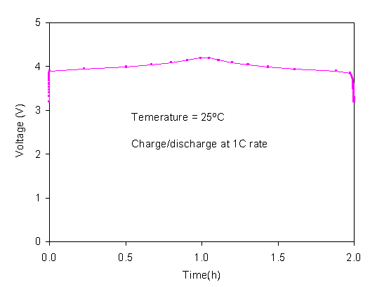 Figure 2: Charge/discharge profile of Excellatron's thin film battery at 25ºC.  Figure 3: Charge/discharge profile of Excellatron's thin film battery at 150ºC. 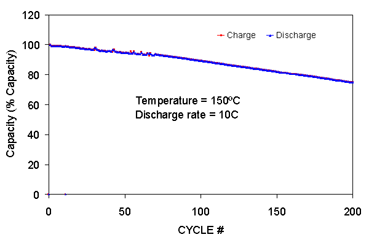 Figure 4: High temperature (150ºC) charge and discharge capacity as a function of cycle number for a thin film battery. Sample was charged at 4.2V and discharged at 10C rate with a duty cycle of 100 ms on, 100 ms off. 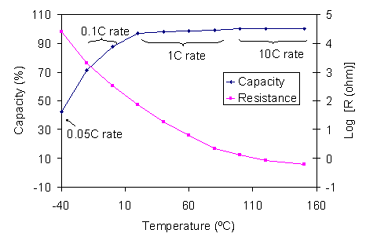 Figure 5: Capacity and resistance of Excellatron's thin film battery as a function of temperature. When the temperature is increased from 20ºC to 150ºC, battery resistance decreases to 5% of its original value.
Figure 6 shows the high rate pulse discharge of Excellatron's battery (0.1 mAh). It is discharged by a 100 mA Pulse at 80ºC (~ 1,000C Rate). Detail of the pulse discharge is shown in Figure 7.
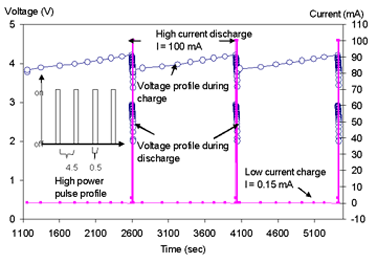 Figure 6: Excellatron's battery (0.1 mAh) discharged by a 100 mA pulse at 80ºC. 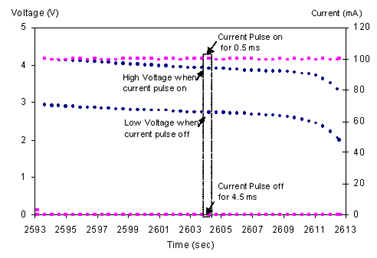 Figure 7: Details on the high rate pulse discharge of Excellatron's battery (0.1 mAh). It is discharged by a 100 mA Pulse at 80ºC (~ 1,000C Rate). Long Cycle Life Unlike any other battery technology, thin film solid state batteries show very high cycle life. Using very thin cathodes (0.05µm) batteries have been cycled in excess of 45,000 cycles with very limited loss in capacity. As can be seen from Figure 8, after 45,000 cycles, 95% of the original capacity remained. When thicker cathodes are used, cycle performance still far exceeds any current battery technology. Figure 9 shows cycle performance for an Excellatron cell with a 2μm thick cathode. With a cycle life in excess of 2,000 cycles, it exceeds the best performance of conventional battery cells by over a factor of two. The best cycle life available from conventional cells is less than 1,000 cycles at 80% capacity loss.
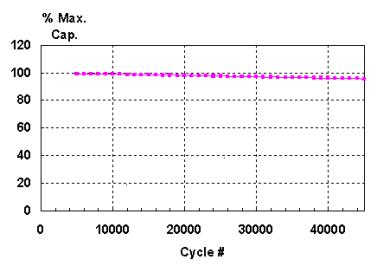 Figure 8: Long term cyclability of a thin film solid state battery
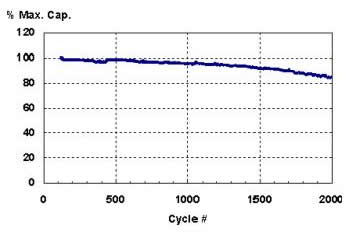 Figure 9: Long term cyclability of an Excellatron thin film battery Discharge capacity of thin-film batteries depends on the choice of cathode and anode materials as shown in Figure 10. LiCoO2 can be used in applications where a high rate, high voltage profile is required. V2O5 can be used in applications where a low rate, large capacity is preferred.
 Figure 10: Discharge capacity of several typical cathode materials. Polymer Film Substrate for Thin Flexible Profile Excellatron has developed a low temperature deposition process for thin film batteries that enables us to use flexible, polymer foil as the substrate. This technology largely reduces the production cost of the thin film batteries. Successful development of a low temperature manufacturing process (<350ºC) opened up the possibility of using a polymer substrate such as Kapton, thereby significantly reducing manufacturing cost, while gaining flexibility and significantly reducing the overall thickness of the cells.
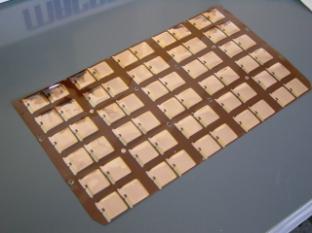 Figure 11: Thin film batteries deposited on a thin polymer substrate. Unique Proprietary Passivation Barrier and Packaging SolutionA unique packaging technology has also been developed by Excellatron, enabling long-term shelf life of thin film batteries under harsh environmental conditions, such as high pressure, high temperature, and high humidity. A combination of organic and inorganic coatings is used to protect the batteries. Excellatron has produced more than 10,000 prototype batteries and has provided samples to two major semiconductor manufacturers for evaluation and testing. Many other companies have also requested samples. The pictures of some of Excellatron's batteries are shown in Figure 12.
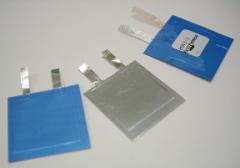 Fig. 5. Rechargeable thin film solid state batteries manufactured by Excellatron. Table 1 shows a comparison of battery performance for various rechargeable batteries, including data for thin film batteries using very thin substrates. Thin film lithium batteries have the potential to reach an energy density as high as 1000 Wh/l. In the future, cell phones and laptops using these thin film batteries will be capable of running up to four times longer than on other lithium ion batteries having the same physical size. Table 1. Comparison of battery performances
High Rate Capability The power rate of most conventional batteries is limited by high internal resistance and the danger of over-heating. The discharge and charge rates of batteries are measured on a scale normalized to the amount of current flow required to either fully charge or deplete a battery in one hour. This rate is referred to as the C-rate. For example, charging a 100 mAh battery at 100 mA for one hour is equivalent to a 1C rate. Most conventional batteries are limited to a charge/discharge rate of < 2C rate. Excellatron's thin film batteries show remarkable rate capability. They can be discharged at a rate of more than 60C during continuous discharge. A much higher discharge rate (up to 1,000C) has been demonstrated during pulse discharge at elevated temperatures. This characteristic has important implications for the burst power requirements of digital transmitters, implantable heart defibrillators, and many other devices.High Capacity Thin Film Batteries
Typical characteristics of Excellatron's batteries are shown in the following table. The nominal capacities of Excellatron's high performance thin film battery are 0.1 mAh, 0.5 mAh, 1 mAh and 10 mAh (size of the battery increases with increasing capacity).
Figure 12 shows the voltage and current profile of a 10 mAh Excellatron battery. The battery capacity is 10 mAh. It is charged at a constant voltage of 4.2V and discharged at 10 mA. The charge current exceeds 50 mA.
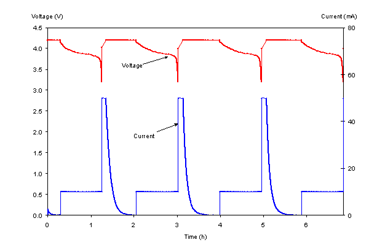 Figure 12: Performance of an Excellatron thin film lithium battery. The battery capacity is 10 mAh. It is charged at a constant voltage of 4.2 V and discharged at 10 mA. The charge current exceeds 50 mA. |